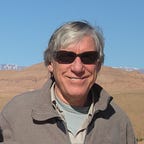What is the Connection Between a Pump with no Moving Parts and Flin Flon?
During the first two decades or more of the opening of the zinc casting plant operated by Hudson Bay Mining & Smelling Co. in Flin Flon, Manitoba, a worker had to manually lower a label mounted on a pulley into the molten zinc, draw it out, and pour the hot liquid metal without delay into the ingot molds arraigned on the casting bench. The main problem with pouring zinc, as I understand it, is that in melts at a rather low temperature, 420o C (787o F). (One could easily melt zinc in the the self cleaning temperature of an electric stove. By contrast, Copper melts at 1,084o C). The metal cooled so quickly one had to work fast to fill the mold increasing the danger to the operator and resulting in some spillage and lost production.
This is where the pump with no moving parts comes into play.The electromagnetic pump was invented by Ben Morrison who worked in the research department of the mining company and invented the pump to move molten zinc from the furnace more safely and efficiently to the casting wheel which had replaced the casting bench. How did the pump help in this process. Picture an electromagnet, a coil of wire with a hollow centre. A current is sent through the coils to activate the magnet. Though zinc is not magnetic, in does react with a magnetic field; when the electromagnetic pump is lowered next to the molten zinc, the zinc ‘shoots’ up the middle of the magnet. The zinc does not touch the sides of the inside of the cylinder because of the magnetic force ‘pulling’ equally from all sides. At the top of the centre of the coil an inverted trough diverts the zinc horizontally into another trough, right side up, so that it can flow into the molds of the slowly moving casting wheel. This new system, which I observed in operation when the science club I belonged to visited the plant in the late 1950s, saved the company millions of dollars in time and wastage.
During the 15 years he worked for the Hudson ay Mining and Smelting Co. in Flin Flon he also invented an electromagnetic instrument that was used to discover several mineral deposits in the Flin Flon area and beyond, using the earth’s magnetic field. “The electromagnetic system resembles a large hula-hoop that is towed beneath a helicopter to measure tiny voltages that can be used to map the earth’s subsurface. … These surveys involve flying low to the ground following a specific planned path to measure the electrical properties of the earth’s subsurface.” (Google reference) The system is also used currently to discover aquifers as well as mineral and non-mineral deposits. Not incidentally, during World War II, he volunteered to serve in the RCAF in 1941 and was made a flight lieutenant, providing instruction in navigation and armaments. He designed an improvement to an automatic gunsight for allied fighter aircraft.
In 1959, Benjamin Morrison, was offered a research position at the University of Saskatchewan where he continued his work on geophysical exploration using magnetic fields. It is noteworthy that at the time he had not even finished his first degree which he completed a few years later at the same time his eldest son, Don, completed his first degree. Mr, Morrison lived to be 101 years old and died in 2004, well remembered by friends and colleagues in Saskatoon and people like me who knew him while growing up in Flin Flon.
Ben Morrison was not the only person to excel is the areas of math and science. In a desperate claim to a sliver of fame, I beat my classmate and neighbour, Leslie Roberts, on one math quiz in Great 8. I got 97% and he received 96% as I recall. We both made simple arithmetic errors, not errors in logic. That is when I peaked in math.
Leslie Roberts was head and shoulders above my cohort in every grade. In the final exam (standard exams set by the Province in those days) there was one question that the teachers could not answer. I heard that they had a sudden inspiration; they decided to peek at Leslie’s paper before it was sent to Winnipeg for marking. He had the correct answer. In another anecdote I heard while we were both studying at the University of Manitoba, a professor stormed angrily into class after one test and lamented that every student had failed, except Mr. Roberts, of course. He went on to get a Ph.D in math at Harvard University and spent his career as a professor in the Department of Mathematics and Statistics at Queens University. He has more than 34 recent publications such as: Roberts, L.G. “Certain projective curves with unusual Hilbert function”, Journal of Pure and Applied Algebra, 104, 1995, 303–311. I don’t pretend to know what a Hilbert function is.
Ben Morrison and Leslie Roberts are but two of many residents of Flin Flon who made notable contribution is the areas of math, science, engineering and medicine.
